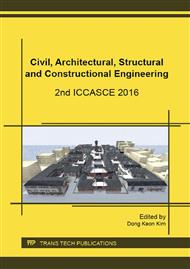p.44
p.50
p.57
p.61
p.67
p.73
p.81
p.86
p.91
AHP Model for Evaluation of Pile Installation Methods
Abstract:
As an economical way of transmitting the loads from structures to the soil or rock layer, pile foundations have been widely applied in construction projects. With an objective of developing a model for selecting the optimum pile installation method for a project, this study investigated three alternative methods that are commonly used in Taiwan. Based on a review of related researches, a generic evaluation framework of a hierarchy comprising 21 factors in four groups is proposed and a model using the analytical hierarchy process (AHP) to produce the weight of the factors and the ratings of the pile installation methods is presented. The model is illustrated using an example, in which the rankings of the alternative methods from best to worst are precast pre-stressed bored piles (PPBP), cast-in-situ concrete piles (CISP) and precast pre-stressed driven piles (PPDP). Practitioners may use the model as a structured, systematic and effective approach in evaluating and selecting the installation method for a project.
Info:
Periodical:
Pages:
67-72
Citation:
Online since:
November 2016
Authors:
Price:
Сopyright:
© 2017 Trans Tech Publications Ltd. All Rights Reserved
Share:
Citation:


